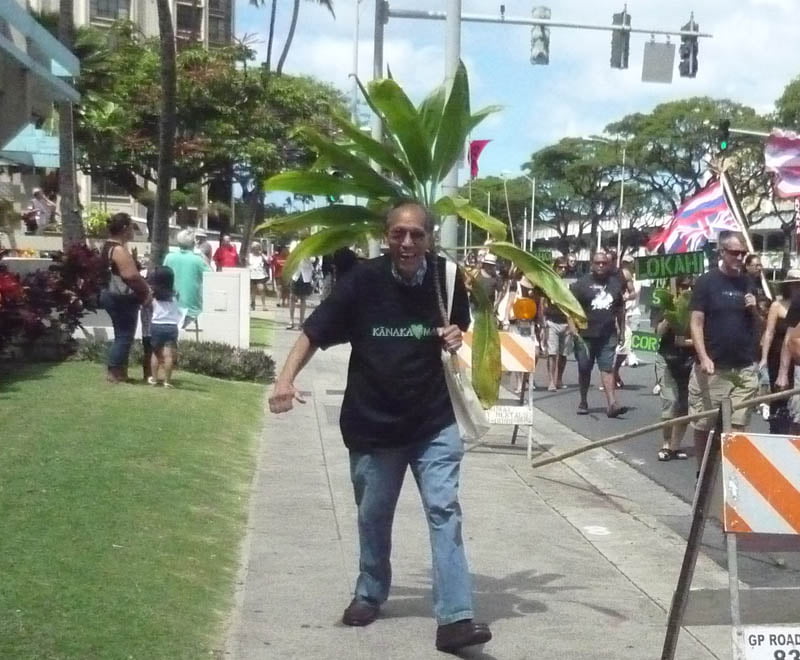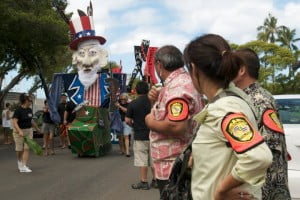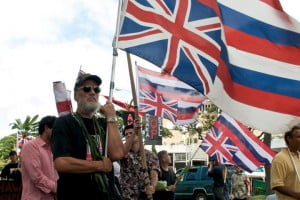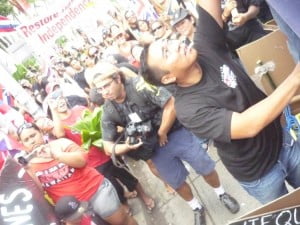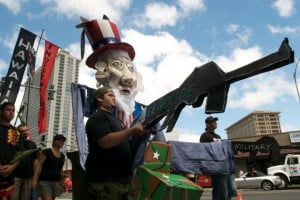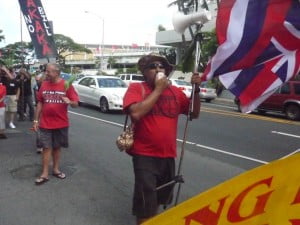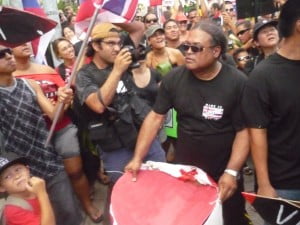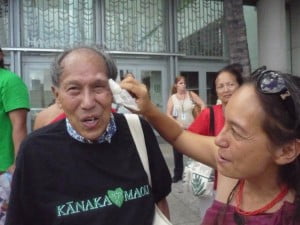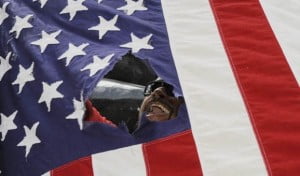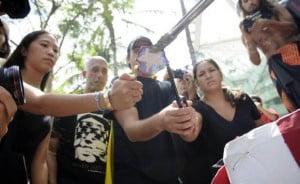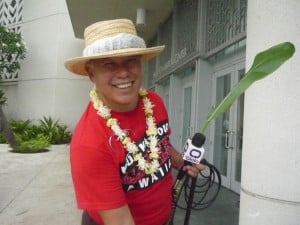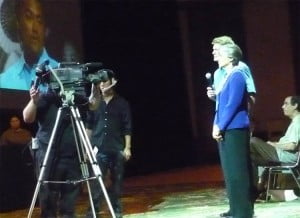SPECTER OF SOVEREIGNTY
August 21, 2009. Hawaii’s 50th anniversary of statehood commemoration was an event that changed the way that we think about statehood. The events inside and outside the convention center brought disparate viewpoints together in a manner where voices and histories could exist side-by-side, speaking with each other not through words, but by presence.
If this presence revealed itself throughout the day as a specter, we were reawakened to the manifest life that this land embraces. Later in the evening, at a separate event organized by Manu Kaiama and with the cooperation of Friends of Iolani Palace director Kippen de Alba Chu, oli or chants were performed at Iolani Palace.
It was solemn to hear the words spoken by Kamehameha III on July 26, 1843 “Ua Mau Ke Ea O Ka ‘Aina I Ka Pono”– The Sovereignty of the Land is Perpetuated in Righteousness– as if these words were spoken by the dusk and its shadow.
The chanters, using only the acoustics of the palace balconies and porch, gave meaning to the day. Oli brought to life what has been most obscured by the statehood debates– and that is reviving the breath of Aloha as proof of the continued life of the Kingdom of Hawaii.
Early in the morning, I picked up a friend Charlie T., who agreed to assist me as camera-person (who shot this video), and by the time we arrived at the convention center, we had already missed the opening remarks by Gov. Lingle.
After registering with our media badges we were able to catch the remarks by pollster John Zogby, in which he presented data from his online poll regarding the Akaka Bill.
Polls, like the 1959 plebiscite, are an important indicator of how people feel about an issue, but they do not unfortunately, reveal what people know about it. If these same questions were brought to attention alongside historical facts and supporting evidence, it would be interesting for Zogby to revisit some of this data.
As residents of the State of Hawaii or descendants of citizens of the Kingdom of Hawaii, we too should consider the facts: the lack of evidence for annexation, as well the statehood process, and revisit the plebiscite along both popular and historically determined methods. It would reveal that the specter of sovereignty is very much present, and hovering over Hawaii’s occupation.
At 10 am. we didn’t want to miss the rally protesting statehood beginning at Ala Moana park, so we left. I had hoped to catch writer/filmmaker Tom Coffman (whose book “A Nation Within” has been just re-published in an updated edition), but things had started late at the Convention Center and so unfortunately, I had to miss hearing him speak. He did however, give me a copy of his speech when I ran into him later that day.
At the rally, I had the opportunity to interview the outspoken veteran activist Pomoi, or Richard Kinney in which he discussed Hawaii, the fake state.
We then interviewed Henry Noa of the Reorganized Hawaiian Kingdom, where he was able to share his views on the illegitimacy of Hawaii’s statehood. I had hoped to conduct more interviews, however, the rally began on time and we organized along the park’s entrance waiting for our police escorts to shut down the lanes along Atkinson Dr. and halt the traffic from Ala Moana Blvd.
The effigy of Uncle Sam was appropriately menacing and historian, Dean Saranillio, pushed the twelve foot scowl rising above the crowd on a cardboard tank.
Uncle Scam (as he was called) held cardboard M-16s, and in his hat, like the Yankee-Doodle Dandy, he wore feathers with some other American territories past and present that suffered under U.S. imperialism: Cuba, Puerto Rico, Philippines and Guam.
Andre Perez, led the chant of 300-400 protestors, “Uncle Scam, get out of our way!”
The rally occurred almost entirely without incident. Two minor unfortunate events occurred. A woman walking her dog stood in front of one of the protester’s banners and would not budge, but that resolved without any hurt feelings. The second, was that Kekuni Blaisdell stumbled. He hit his head on the curb and received a sizable bump. This caused concern from not only the protesters, but also from many inside the convention center as well.
Towards the staging area at the end of the march, we were gathered under Uncle Scam. Lynette Cruz called for the knocking off of Uncle Scam’s hat. As it fell, mass catharsis began and a couple of protesters began assaulting Uncle Scam with sticks, while in keeping with the program, we waited in anticipation for the flag to be pulled out from the hat, the 50th star be cut out and set to ash in little blush of smoke. I heard that the star was going to be put in an envelope and sent to Obama, but they decided on burning the star instead.
Since before the March 18th Statehood day protest at the capitol, one could feel the emotional stress of the last several months burn away with that star.
Following, Poka Laenui, one of the event organizers, began speaking on the issue of occupation and Hawaiian independence, and was later joined by Tony Castanda discussing Puerto Rican occupation, and others on the Philippines, Guam, Cuba, and other U.S. territories, including the American soil on what some native Americans call Turtle Island.
While in the convention center, I escorted Kekuni to the “Economic Forecast Luncheon, Emerging from the Global Recession: Near Term Economic Prospects for Hawai‘i, the U.S., and the World,” presented by First Hawaiian Bank.
Holding an ice pack in a ti leaf to his forehead to keep the swelling down, we turned quite a few heads of those who were invited or paid for this high-ticket luncheon.
The table we were invited to sit at included Professors Eleanor Nordyke, Laura Theilen and Randall Roth and his wife who I had the fortune of speaking with later that day.
The economic outlook that was presented at the Statehood Commemoration luncheon was perhaps only appropriately optimistic, in part, because the presenters ignored significant potential risks to Hawaii’s financial future. Some of the risks overlooked in this economic forecast were the real unemployment numbers, the future of the dollar as the international trading currency, and a hard examination of our current state and national economic policy, i.e, how do we become a stronger exporter of non-subsidized resources and commodities… that kind of stuff.
Throughout the event, I was able to interview Judge Burns, Dan Boylan, Michael Pili Pang, Kamana Beamer, Donavan Presa, Kippen de Alba Chu, the co-chair of the Statehood Commission. I thanked Lenny Klompus for his hard work on putting together this event and for successfully leading the Commission thoughout this process. As they appeared, I would corner other members like Allicyn Tasaka, Tammy Kubo, Ted Tsukiyama.
When we entered the “Historical Overview” session with Judge Burns, Dan Boylan and Rich Budnick, I felt as though Judge Burns greeted me by admonishing my analysis of the plebiscite, and the dismissal of the UN perspective that I’ve been advocating. We shared a good laugh when I called him on it later.
I also had the opportunity to interview Dan Boylan who will be hosting the “State of Aloha” roundtable on Hawaii PBS on Thursday at 7:30. This is the Academy for Creative Media film that my wife Ruth Chon has edited. Dan Boylan is credited as “Writer,” and I’m credited as “Lead Historical Researcher.” Nanette Napolean is the “Lead Archival Researcher.”
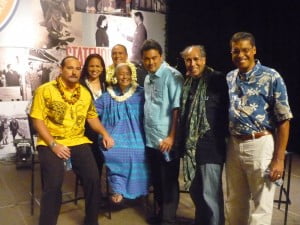
The final panel, “Native Hawaiians: Cultural Navigation in a Sea of Change,” was hosted and broadcast by KGMB. Panelists included Dr. Jonathan Osorio, Dr. Trisha Kehaulani Watson, Kimo Alama, Pono Shim, Ramsey Taum, Dutchie Saffery, Donovan Presa, Dr. Kamana Beamer.
The questions asked were on the issue of “ceded” Lands and the Akaka Bill. Linda Lingle sitting in the front row had the last response on the ceded land issue before the talk ended and it was cut to commercial.
In this discussion, the issue of crown lands and lack of a legitimate annexation treaty came up. Governor Lingle, spoke to the issue, saying that the recent Supreme Court ruling was a state issue and different from the “historical” issue. From her perspective, she did a good job at keeping the issue of annexation divided by the Admission Act.
The crown lands are still crown lands, said Dr. Beamer and Donavan Presa in agreement.
Until the state or the United States produces a legitimate treaty of Annexation, Hawaii is not a state, and it is simply an occupied territory.
Most important about Lingle’s response however was her omission to acknowledge the assertion: “Show us the treaty…” She could not directly respond to that, and her omission suggested to many in the audience that there is legitimacy to the claim that something is unresolved with Hawaii’s annexation.
After Gov. Lingle spoke, KGMB cut to a commercial not leaving any room for the panelists to respond. The next question was on the Akaka Bill, which none of the panelists outrightly supported. OHA Trustee, Oz Stender spoke last and again KGMB cut to a commercial not leaving an opportunity for a response.
The surprise answer however, was given by Pono Shim on the question of “ceded” lands. Shim asked the KGMB hosts who asked the online question, and when they responded, “Ken Conklin,” Shim argued that the question was manufactured to split the community and refused to answer it the way in which it was written.
Predictably, this panel, the high-point event of the commemoration, spoke to the heart of the dialogue that went on between groups inside and outside of the convention center: independence.
I left the convention center and arrived at Iolani Palace to catch the last half of Victoria Kneubuhl’s reenactment of the overthrow, and the special oli that was performed in Iolani Palace following.
In honor of Queen Lili’uokalani, chanters brought the palace to life.
Beginning just before dusk and continuing into night, the palace had become a truly transformational locale in which voices, without any amplification, led all who were present to restore what is most true about this place: the land, its people and the recovery of a nation.
I was reminded of what led me to pursue this statehood project, and it was the 1993 Onipa’a, the 100th anniversary of the overthrow, in which I wrote a paper while a graduate student at NYU’s Performing Studies called Restoring the Loss. It is an incomplete paper, in part, due to, regretfully, having written it outside Hawaii and outside of the sovereignty movement. If I had been able to stay behind and continue with the research, I may have been privileged to have attended the Sovereignty Tribunal which occurred eight months later. The paper has several historical flaws and faulty constructs, but the essence of restoring loss remains as true then, as it does now.
My special attachment to this 50th anniversary of statehood, was the result of the same understanding of the restorative process and the growth by which we have come to understand Hawaii’s unique history.
Since yesterday, the story of statehood has irrevocably matured. Comments by people who felt threatened by the protesters and the academics and historians, seem irrelevant now. We have control over our history as the facts, unearth. Recovered histories are the wind that I feel sweeping across this socio-political climate. I hope that with this generation, and by the next, Hawaii will further attain the truth which had been never lost, just hidden.
